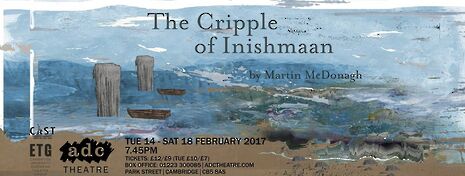Authentically Irish – in Cambridge?
Anunita Chandrasekar speaks to The Cripple of Inishmaan director Rebecca Vaa about the challenge of trying to capture Ireland without the stereotypes

This week’s offering at the ADC, The Cripple of Inishmaan, is a bittersweet tale set amongst a small community on Aran Island that follows the coming of age of the orphaned, crippled protagonist, Billy. The story is far from a conventional bildungsroman though, and those familiar with writer Martin McDonagh from his better known In Bruges, may recognize a flavour of the same black humour permeating the play. Moreover, the play’s twists never quite let the audience become complacent enough to assume they can predict the play’s direction.
This subversion of expectation is what director Rebecca Vaa says endears her to the play, which is a real labour of love on her part. Having long wanted to stage the play, Rebecca waited until she had gained more experience of the theatre scene at Cambridge – this is certainly reflected in the show. Its set is one of the most ambitious seen at the ADC, with rotating panels used to minutely create both the recurring interiors of the play and the wild, beautiful landscapes of Inishmaan.
These sets are one of the facets of the play that help capture the spirit of the close-knitted community of Inishmaan, which is shaken up by the arrival of the real-life director Robert Flaherty. Writer Martin McDonagh stated that he wanted the play to be considered an authentically Irish tale, despite the fact he was an outsider looking in. One of the simplest, yet most effective, ways this is conveyed in the play is through the authentic sounding accents. Rebecca says that getting an accent coach in really helped the cast, none of whom are originally Irish, but notes that acting through the accent provided an additional challenge. Folk music used during scenes further draws on broad associations with Ireland, but these superficially effective means of characterising the location are offset throughout the play by its satirising of those who mythologize Ireland, including Robert Flaherty.
“It is precisely this reduction to myth or emblem that the characters of the The Cripple of Inishmaan resist”
Flaherty’s ethnofictional film, Man of Aran, was set in the same community, but was liberal in its invention of material to create a more rugged, authentic seeming vision of Ireland. It is precisely this reduction to myth or emblem that the characters of the The Cripple of Inishmaan resist for, as Rebecca points out, no character is one-dimensional enough to become predictable; each of them have their charming, and occasionally exasperating, quirks and mannerisms, which the predominantly fresher cast manage to convey brilliantly. The nuances of the plot and character are well handled and make this charming production a theatrical highlight of the week.
The Cripple of Inishmaan runs from Tues 14th - Sat 18th Feb at the ADC, 7:45pm
 News / Copycat don caught again19 April 2024
News / Copycat don caught again19 April 2024 News / Emmanuel College cuts ties with ‘race-realist’ fellow19 April 2024
News / Emmanuel College cuts ties with ‘race-realist’ fellow19 April 2024 Theatre / The closest Cambridge comes to a Drama degree 19 April 2024
Theatre / The closest Cambridge comes to a Drama degree 19 April 2024 News / Acting vice-chancellor paid £234,000 for nine month stint19 April 2024
News / Acting vice-chancellor paid £234,000 for nine month stint19 April 2024 Interviews / ‘People just walk away’: the sense of exclusion felt by foundation year students19 April 2024
Interviews / ‘People just walk away’: the sense of exclusion felt by foundation year students19 April 2024




